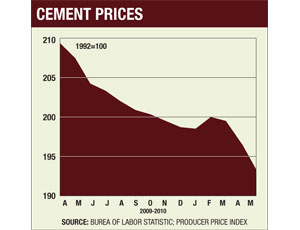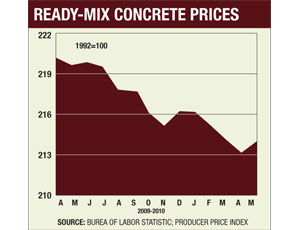A mid high unemployment and a credit freeze that has delayed or eliminated construction plans, a dip in cement consumption drove down prices during the first half of 2010. Cement prices have fallen in six of the last seven months, including relatively large monthly declines of 1.5% in April and 1.4% in May, according to the Bureau of Labor Statistics’ producer price index.


“The declines are getting steeper,” says Armine Thompson, construction materials analyst for the Washington, D.C.-based forecasting firm IHS Global Insight. In May, cement prices were 6.8% below a year ago. Ready-mix concrete prices are following a similar pattern and, in May, were 2.7% below 2009’s level, according to BLS.
However, cement and concrete prices may be close to bottoming out, says Thompson. “We have seen domestic shipments start to increase over the last few months, and in April, shipments were up 10% over a year ago,” she says. “Prices usually lag shipments a bit, so we expect to see cement prices level off near the end of the year.” Thompson predicts cement prices in the fourth quarter of this year will be only 0.1% lower than the fourth quarter of 2009.
The Portland Cement Association, Skokie, Ill., is forecasting a small 3-million to 5-million metric-tonne increase in overall U.S. cement consumption in 2010. Much of the current boost in shipments is coming from federal stimulus spending. In May, total stimulus spending was $941 million, a 48.8% increase from the level in April.
PCA expects stimulus spending combined with a stronger residential market, greater transportation investment and job growth will all help to ratchet up total U.S. consumption between 2010 and 2014, bringing it near to the industry highs of 2005 and 2006, which would be a major turnaround for the industry.
Last year, commercial building cement consumption reached a 38-year low at just over 60 million tonnes, causing low kiln use rates, extended plant downtimes and high inventory levels, says PCA chief economist Edward J. Sullivan. Like many cement producers looking to cut back, Zurich-based Holcim Ltd. responded by closing a Missouri plant and a Michigan plant and stopping production at its Iowa and Mississippi plants in the last four years. Cemex SAB de CV, Garza Garcia, Mexico, this year announced plans to close its Davenport, Calif., plant.
“Cement capacity is now plentiful,” says Will Hill, managing director of Raleigh, N.C.-based FMI Corp. “Just a few short years ago, allocations and shortages were common across the United States. With the opening and expansion of several plants, this will not be an issue for several years out.”
Holcim is making a billion-dollar bet on that outlook. The company this month opened a new, $1-billion single-kiln cement plant, based in Bloomsdale, Mo., along the Mississippi River. The 4-million-tonne annual capacity facility—touted as one of the world’s largest—debuts during a multidecade low in cement demand. The new plant will more than make up for the four plant closures, the combined capacity of which was about 3.7 million tonnes a year. Holcim began construction of the new plant during boom times in 2006. “[I’m] banking on cement demand to improve in 2011,” says Holcim U.S. President Bernard Tarver.
“Construction is down, which means cement supplies are up,” says Mike Olson, president of Olson Precast Co., a Phoenix-based concrete contractor. “Pricing doesn’t have much effect on how much cement we use so much as the specifications and design provided by the owner.”
The steep decline in cement prices have some owners reconsidering concrete as a cost-competitive asphalt alternative for street and highway construction, which accounts for about 30% of all cement consumption, says PCA.
“With the drop in prices, we almost doubled the number of projects planned with our stimulus monies because the bids were so competitive,” says Scott Magruder, spokesman for the Nevada Dept. of Transportation. “We currently are considering concrete paving—as opposed to asphalt—on our Interstate 580 freeway project, between Reno and Carson City, due to pricing.”

Post a comment to this article
Report Abusive Comment